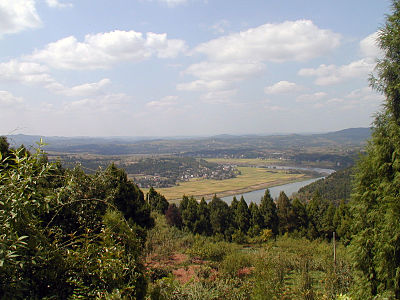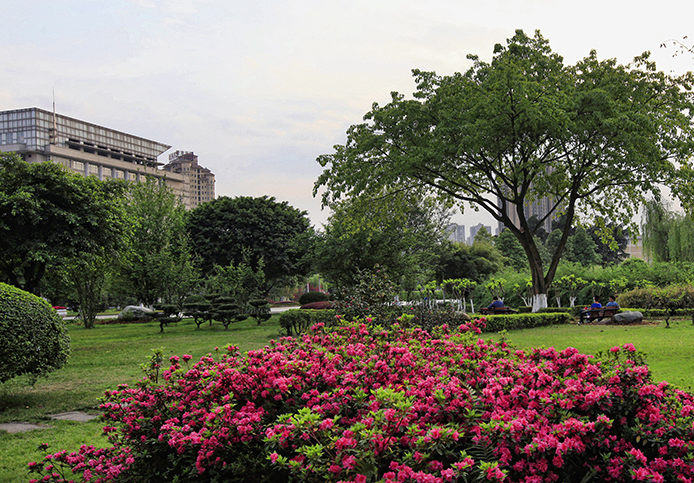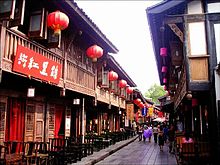South-West petroleum University
Chengdu city ,Sichuan Province
sichuan at a closer look Panda in Chengdu
Chengdu is a sub-provincial city which has served as capital of China's Sichuan province. It is one of the three most populous cities in Western China. As of 2014[update] the administrative area houses 14,427,500 inhabitants, with an urban population of 10,152,632. At the time of the 2010 census, Chengdu was the 5th-most populous agglomeration in China, with 10,484,996 inhabitants in the built-up area including Xinjin County and Deyang's Guanghan City.
The surrounding Chengdu Plain is also known as the "Country of Heaven" and the "Land of Abundance". Its prehistoric settlers included the Sanxingdui culture. Founded by the state of Shu prior to its incorporation into China, Chengdu is unique as a major Chinese settlement that has maintained its name (nearly) unchanged throughout the imperial, republican, and communist eras. It was the capital of Liu Bei's Shu during the Three Kingdoms Era, as well as several other local kingdoms during the Middle Ages. After the fall of Nanjing to the Japanese in 1937, Chengdu briefly served as the capital of China. It is now one of the most important economic, financial, commercial, cultural, transportation, and communication centers in Western China. Chengdu Shuangliu International Airport is one of the 30 busiest airports in the world, and Chengdu Railway Station is one of the six biggest in China. Chengdu also hosts many international companies and more than 12 consulates. More than 260 Fortune 500 companies have established branches in Chengdu.
An Introduction to Si Chuan Province


Sichuan, formerly romanized Szechuan, is a province in southwest China occupying most of the Sichuan Basin between the Himalayas on the west, the Daba Mountains in the north, and the Yungui Plateau to the east. Sichuan's capital city is Chengdu.
In antiquity, Sichuan was the home of the ancient states of Ba and Shu. Their conquest by Qin strengthened it and paved the way for the First Emperor's unification of China under the Qin Dynasty. During the Three Kingdoms era, Liu Bei's Shu was based in Sichuan. The area was devastated in the 17th century by Zhang Xianzhong's rebellion and the area's subsequent Manchu conquest, but recovered to become one of China's most productive areas by the 19th century. During the Second World War, Chongqing served as the temporary capital of the Republic of China, making it the focus of Japanese bombing. It was one of the last mainland areas to fall to the Communists during the Chinese Civil War and was divided into four parts from 1949 to 1952, with Chongqing restored two years later. It suffered gravely during the Great Chinese Famine of 1959–61 but remained China's most populous province until Chongqing Municipality was again separated from it in 1997.
The people of Sichuan speak a unique form of Mandarin, which took shape during the area's repopulation under the Ming. The family of dialects is now spoken by about 120 million people, which would make it the 10th most spoken language in the world if counted separately. The area's warm damp climate long caused Chinese medicine to advocate spicy dishes; the native Sichuan pepper was supplemented by Mexican chilis during the Columbian Exchange to form modern Sichuan cuisine, whose dishes—including Kung Pao chicken and Mapo tofu—have become staples around the world
Abbreviation: Chuan 川or Shu蜀
Capital: Chengdu
Area: Approximately 480,000 square kilometers
Population: 84.74 million
Location: In southwest China and the upper reaches of the Yangtze River
Overview of the Southwest Petroleum University

Southwest Petroleum University (SWPU), the second petroleum university in the People's Republic of China, was founded in 1958, andis now administered and supported by Chinese central government and Sichuan province local government, with the latter playing a biggerrole.
SWPU has 16 schools, 1 Photo voltaic Industry and Technology Research Institute, 1 Institute of New Energy and UnconventionalOil and Gas, and 1 engineering training center. There are 8 subjectgroups: science, engineering, management, economics, arts, law, education and artistics. 65 programs under those subject groups are qualified to recruit undergraduates; 4 first-levelprograms and 24 second-level programs are authorized to offer doctoral degrees. 18 first-level programs and 86 second-level programsare authorized to offer master’s degrees. Thereare 4 postdoctoral research stations, 1 first-level program and 3 second-level programs, which are all recognized as national key programs.
This university contains2 state-level teachers’ teams, 3 state-level experimental teaching demonstration centers, 2 state-level experimental teaching centers of virtual simulation,and 3 innovators’ teams supported by “Program for Changjiang Scholars and Innovative Research Team in University” of China’s Ministry of Education.
This university has a staff of 2,412,of whom 230 are full professors, senior engineers and other senior professionals, and 574 are associate professors, associate senior engineers and other associate senior professionals. There are 1,664 full-time teachers, including 2 Chinese Academy of Engineering academicians, 3 State Council Academic Degrees Committee members, 2 “National Science Fund for DistinguishedYoung Scholars” receivers, 3 Distinguished “Changjiang Scholars Program” Professors, 2 “Sichuan Spire Talents Training Project”candidates, and 8 “New Century Hundred-Thousand-Ten Thousand Talents Project” candidates.
SWPU has 111 scientific research bases on all levels,which have undertaken 2,679 government research projects and 3,757 petroleum industry sponsored research projects since the initiation of China’s 12th Five-YearPlan. SWPU has been awarded the grand prize and first prize of “NationalScience and Technology Progress” and the second prize of “National Science and Technology Progress and Invention”, totaling 133 times; the university has been awarded state-level teaching achievement prizes and ministerial-level teaching achievement prizes, the former amountingto 8 times while the latter 84 times.
For academic exchanges and research collaboration, SWPU has established close ties with universities and academic research institutionsin the United States, Russia, Britain, Germany, Japan, France, Canada, etc.
SWPU has two campuses, one in Chengdu and the other in Nanchong,covering an area of over 200 ha. The current student body on the two campuses includes26,490 undergraduates, 3,801 graduates, 715 PhD candidates and 49 international students. So far SWPU has produced more than 146,000 bachelors, masters and doctors, many of whom havee stablished themselves as preeminent specialists and scholars, great statesmen,successful entrepreneurs, or technological and managerial backbones in various fields.
In the spirit of “fuel up our country and gas up ournation”, and in keeping with the motto of “righteous deed, persistent quest,extensive learning and creative mind”, SWPU has formulated a “second-time pioneering strategy” to achieve the goals of becoming a first-class university in China and getting the leading-edge programs recognized worldwide before celebrating her 100thanniversary.


English Teachers Number required: 4 Posts
Requirements: BA ,TESOL and some teaching experience preferred
Contract Period: 1st Mar, 2025 - 15th Jan, 2026
1st Sep, 2024 - 15th Jul, 2025
Monthly Salary: 9,000 RMB or above
Teaching hours: 16-18 classes per week
Age of students: 18-22 years old
Accommodation: provide good accommodation, telephone, air-condition ,Color TV, refrigerator, A-Z miscellaneous items (bedding, blanket, pillow, towel, sleeper, etc)
Number of students per class :60
Other Perks: Free Mandarin lessons
Holiday Allowance: 2200 RMB
Work permit : The school will provide work permit for China at no cost to the teacher.
Air-ticket Reimbursement:
When foreign teacher finish one-year contract , one-way air-ticket reimbursement will be made
Closest Airport: Chengdu Shuangliu International Airport
